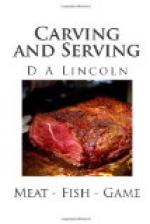A very important matter is the condition of the knife. It should have a handle easy to grasp, a long, thin, sharp, pointed blade, and be of a size adapted to the article to be carved and to the person using it. A lady or a child will prefer a small knife. Be as particular to have the knife sharp as to have it bright and clean; and always sharpen it before announcing the dinner. It is very annoying for a person to be obliged to wait and sharpen the knife, or to turn the meat round to get it into the right position. Never allow a carving-knife to be used to cut bread, or for any other than its legitimate purpose.
The fork should be strong, with long tines, and should have a guard.
Place the fork deep enough in the meat so that you can hold it firmly in position. Hold the knife and fork in an easy, natural way. Many persons grasp the fork as if it were a dagger, and stab it into the meat; but such a display of force is unnecessary and clownish. The hand should be over the handle of the fork, the palm down, and the forefinger extended.
Do not appear to make hard work of carving. Avoid all scowling or contortion of the mouth if a difficult spot be touched. Don’t let your countenance betray the toughness of the joint or your own lack of skill. Work slowly but skilfully, and thus avoid the danger of landing the joint in your neighbor’s lap.
Do not be guilty of the discourtesy of asking each guest, before you begin to carve, to choose between roast lamb and warmed-over beef, or between pie and pudding, or whatever you may have, and thus cause a guest who may have chosen the lamb or the pie the discomfort of knowing that it has been cut solely for her. Such economy may be excusable in the privacy of one’s own family, but not in the presence of invited guests. First divide or carve what you have to serve, and then offer the choice to your guests.
“To carve and serve decently and in good order” is indeed mainly the duty of the host; but there is sometimes an unfortunate lack of skill on the part of the hostess in her share of the serving. A certain pride is permitted to her, and is expected of her, in serving neatly her tea, coffee, and soup, in dividing appropriately her pies and puddings, and even in cutting and arranging deftly the bread upon her board.
A word to the guest, and then we will proceed to explicit directions.
Never stare at the carver. Remember you are invited to dine, not to take a lesson in carving. Appear perfectly unconscious of his efforts; a glance now and then will give you sufficient insight into his method. There often seems to be an irresistible fascination about carving which silences all tongues and draws all eyes to the head of the table. The most skilful carver will sometimes fail if conscious of being watched. With a little tact the hostess can easily engage the attention of her guests, that the carver may not be annoyed.




